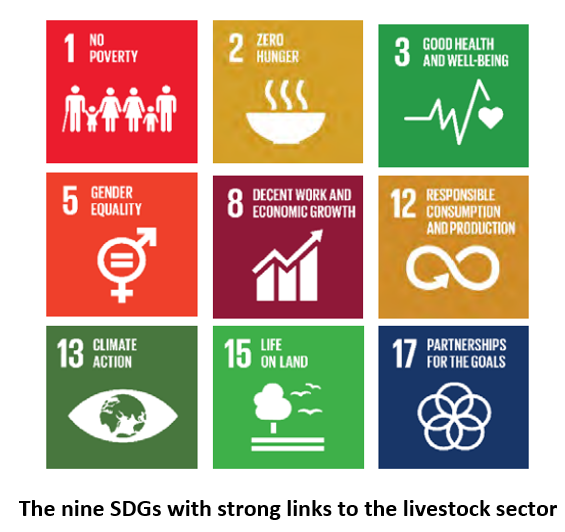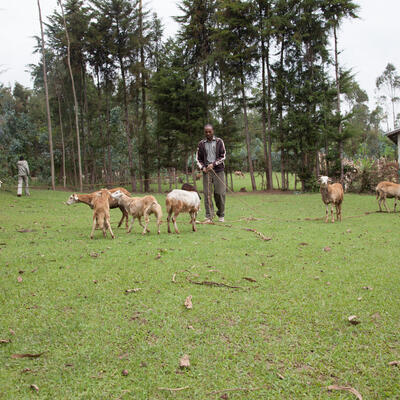
Growth and innovation in the livestock sector could help spur global sustainable development
With the demand for livestock products projected to increase by more than 70 per cent between 2005 and 2030, it is becoming increasingly important to understand livestock’s role in global sustainable development. A recent paper by Fritz Schneider, chair of the Independent Steering Committee for the CGIAR Research Program on Livestock and past chair of the Global Agenda on Sustainable Livestock (GASL), and Shirley Tarawali, assistant director general of ILRI and present chair of GASL, examines how livestock can contribute to the United Nations Sustainable Development Goals (SDGs), a collection of 17 interlinked global goals designed to be a ‘blueprint to achieve a better and more sustainable future for all’.
The paper appears in a World Organisation for Animal Health (OIE) scientific and technical review titled ‘Veterinary Services in a changing world: climate change and other external factors’. That review was edited by ILRI scientists Delia Grace and Hu Suk Lee along with ILRI director general Jimmy Smith. Also included in that review are other papers from ILRI researchers, including Dolapo Enahoro, Sirak Bahta, Charles Mensah, Stephen Oloo, Karl Rich, Barbara Wieland, Delia Grace, Bernard Bett, Arshnee Moodley and Thomas Randolph.
In their paper, Schneider and Tarawali specifically focus on nine SDGs identified by GASL that are of particular relevance to the livestock sector:

To frame their overview of how livestock influence the SDGs, Schneider and Tarawali highlight livestock’s contribution to four sustainability domains adopted by the 2018 Global Forum for Food and Agriculture in Berlin: food and nutrition security, animal health and welfare, livelihoods and economic growth, and climate and natural resource use.
Although livestock continue to receive mounting criticism in the developed world, the sector plays a central role in enhancing global food and nutrition security in the developing world, which directly relates to SDGs 2 and 3 (zero hunger and good health and well-being). Livestock provide 18 per cent of the total calories and 40 per cent of the protein in global diets. For the world’s malnourished people and other vulnerable groups, including children, pregnant women and the elderly, animal-source foods also contain protein and essential micronutrients not readily available in plant-based alternatives. In addition to their nutritional benefits, livestock contribute to food security through the intricate connections between raising animals and growing crops—for example, the income and manure farmers receive from livestock are integral to the production of over half of the developing world’s staple cereals.
Animal health and welfare, specifically in relation to livestock, are also essential to global sustainable development. They too contribute to SDGs 2 and 3 by mitigating problems that arise out of the relations between animal and human health. The COVID-19 pandemic has revealed the interdependence between animals, people and the environment, highlighting the need for a One Health approach that unites medical, veterinary and environmental expertise in preventing future pandemics and tackling other complex global issues. One of those issues is antimicrobial resistance (AMR) which is a rapidly emerging threat to human health. Livestock are major consumers of antibiotics and thus important potential contributors to global AMR. A One Health approach that supports better animal care and reduces livestock systems’ dependence on antibiotics is necessary to reduce the threat AMR poses to humans. Improving livestock health and welfare can also help to address issues of zoonoses and foodborne diseases.
Well-cared-for livestock will not only benefit human health, but they can also enhance global livelihoods and economic growth, contributing to SDGs 1, 5, 8 and 12 (no poverty, gender equality, decent work and economic growth, and responsible consumption and production). At the beginning of 2020, about 10 per cent of the world’s population (more than 700 million people) was living on less than USD 1.90 a day, and the COVID-19 pandemic is projected to push another 120 million people into poverty. About half of the world’s poor people depend directly on livestock for their livelihoods. In some developing countries, livestock can contribute up to 85 per cent of agricultural GDP, and livestock production remains one of the fastest-growing economic sectors across the developing world. Capturing the economic benefits of the expanding livestock market through training, technological upgrading and innovation can help sustain global economic growth and support hundreds of millions of livelihoods. This is especially valuable in terms of empowering women, who play a major role in livestock production.
Innovations in livestock systems can also help to address climate change and natural resource scarcity, thereby advancing SDGs 12, 13 and 15 (responsible consumption and production, climate action and life on land). While livestock currently contribute 14.5 per cent of global greenhouse gas (GHG) emissions (including both direct and indirect emissions), implementing technical interventions that improve resource-use efficiency in livestock systems can reduce their environmental impact by between 14 and 41 per cent. This is also another area where improving animal health and welfare can have a large impact, especially in places where livestock productivity remains low (mostly in Africa and Asia), as healthier, more efficient animals emit fewer GHGs per unit of production.
In addition to contributing to climate change, the livestock sector is also impacted by climate change—it affects animal performance, feed availability, access to water, animal health and biodiversity. The resilience of livestock systems to climate change can be strengthened through water and grazing management, breeding of both animals and forage crops for drought and heat resistance, and incorporating animal health and welfare into disaster response planning. Pastoral communities, which are among the most vulnerable to climate change, can also play an important role in improved environmental stewardship through grazing and land management practices that promote carbon sequestration and biodiversity conservation.
To ensure that livestock can fulfil all their potential contributions to global sustainable development, Schneider and Tarawali note that animal health services will require greater attention and investment. Healthy, well-cared-for livestock will support greater improvements in food and nutrition security as well as livelihoods and economic growth thanks to their higher productivity—all while having a reduced environmental footprint.
Given the complexity and diversity of the livestock sector, Schneider and Tarawali also call for partnerships between the public and private sectors, governments, NGOs, community-based organizations, academia and intergovernmental organizations. These multi-stakeholder partnerships will contribute to SDG 17 (partnerships for the goals) as well as promote knowledge sharing and an integrated approach that ensure livestock-related policy and sustainable development solutions are tailored to the unique context of different regions.
Overall, while livestock, animal health and animal welfare are rarely mentioned explicitly in the United Nations SDGs, they provide a useful framework through which the world can work towards a more sustainable future. This framework will only become more important as the livestock sector continues to grow around the world.
Amhara country, Ethiopia (photo credit: Arnaud Delberghe)
Related Stories
Linking research-for-development and community needs in the climate-smart livestock systems project
More than money: Setting up livestock investments for gender equity outcomes



















